Pentax 67
The Pentax 6×7, and later the Pentax 67 and Pentax 67II, are streamlined SLR medium format camera systems introduced in 1969 with the original Pentax 6×7 and discontinued in 2009 with the Pentax 67II. The system consists of the camera body, an interchangeable prism viewfinder, and one or more lenses. A standard Pentax 6×7 outfit typically includes a nonmetered pentaprism and a Super Takumar 105mm f/2.4 lens. A wide range of fixed-focal-length and zoom lenses, along with TTL-metered and other finders, were available as additional accessories. This system is sometimes referred to as the P67 in online discussions and forums.
The Pentax 6×7 series of cameras consists of the following models:
- Pentax 6×7, introduced in 1969
- Pentax 6×7 (MU), 1976 improved model with mirror lock-up
- Pentax 67, introduced in 1989
- Pentax 67 II, introduced in 1998
Contents
Pentax 6×7
The Pentax 6×7 is a Japanese medium-format SLR roll film camera by Asahi Pentax. Pentax's plans for a 6x7 SLR arose about 1960. However, there were challenges during the camera's development, including changing from a mechanical to an electronic shutter and adjusting the camera for 220 film use,[1] and it took until the 1966 Photokina for the camera to be presented in prototype form as the Pentax 220. The name reflected that it supported 220 film, which had become available in 1965 (see also the Linhof 220). The prototype had a mixed chrome and black finish.[2] The final version of the Pentax 6x7 launched in 1969 with an all-black finish. It produces 6×7 images on 120 or 220 roll film.
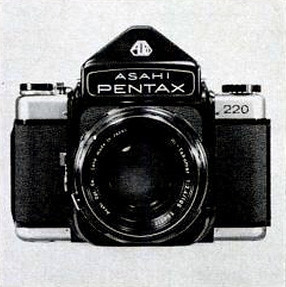
|
| Pentax 220 |
The body is in the style of an oversized 35mm SLR camera; some have referred to it as a "super SLR." The camera has a dual Pentax bayonet lens mount. The inner mount is typically for lenses with a focal length from 35mm to 300mm, while the outer mount is for lengths of 400mm to 1000mm. The shutter is a cloth-based focal plane shutter with speeds of 1 to 1/1000 of a second plus a bulb mode. The camera supports a time (T) mode; to enable this feature the shutter dial has to be set between 1/1000 and X. The shutter release has a locking collar as well as a screw-in cable release connector. For flash synchronisation there are two PC sockets on the left-hand side of the mirror housing, one for FP bulb and another for X electronic sync at 1/30 of a second. There is no cold accessory or hot shoe built in. The optional left-hand grip does contain a shoe. The camera is completely battery-dependent, using a 6V PX28/4LR44 battery. The body does not have a built-in exposure meter.
The film transport uses a single-stroke film advance wind lever. The film automatically stops at the correct frame, so no red window is required. The film counter is located on top of the advance lever. Loading film requires opening the film back by pulling the latch on the left side of the back downwards. The left side of the film chamber is for the unexposed film, and the right for the film take-up spool. The base of the camera has film spool knobs that must be pulled out and aligned with the spools. The film backing paper must be aligned with the start indicators in the film chamber, which has two marks--one for 120 and another for 220. Roll film type can be selected by a small knob on the right-hand side of the camera and by sliding the film pressure plate for either 10 or 20 pictures. Sliding the pressure plate also changes the film type reminder window on the back. The camera shutter does not work without film. To test fire, open the camera back and set the film counter dial on a frame number. Close the back while holding the dial. Crank to cock the shutter. The camera locks again when the counter dial has exposed the last frame.
Mirror lock-up
Early on, the camera had a vibration problem, but in 1976, halfway through its production life, Asahi reduced the problem by introducing a mirror lock-up feature. Sliding a switch on the right-hand side of the mirror housing upwards releases the mirror, while a small, flush button located under the numeral 7 in the model name on the right-hand front allows the mirror/shutter cycle to be completed if the shutter has been released without battery power; after depressing the button (e.g., with a ballpoint pen), press the shutter once more to complete the cycle. This feature does consume power, so remember to release the mirror. When this revised body was introduced, Asahi also offered to retrofit existing cameras.

|
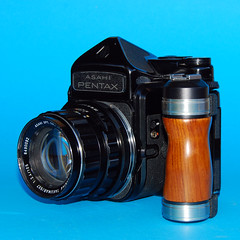 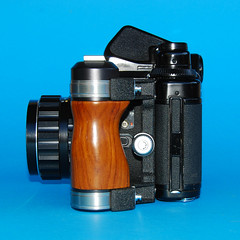 
|
 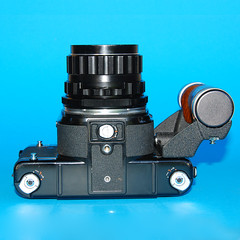
|
| A Pentax 6×7 (MLU) with metered pentaprism and hand grip. image by Dirk HR Spennemann. (Image rights) |
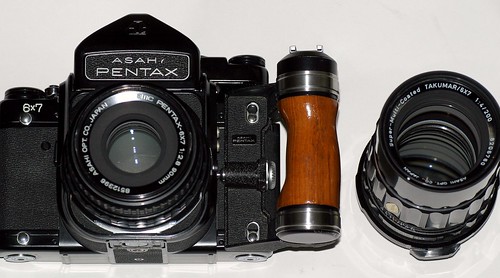
|
| Pentax 6×7 with metered finder, 90 & 200mm lenses. image by rst12. (Image rights) |
Pentax 67
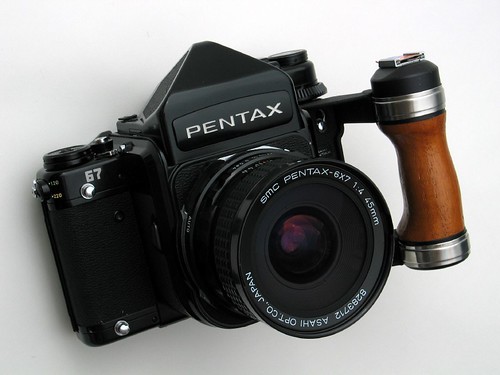
|
| Pentax 67 with TTL prism (67) and LH grip image by Jason Schlachet (Image rights) |
In 1989 Asahi released a newer revision, called Pentax 67. Like all models before and after, it shared very similar specifications. Many of the knobs and buttons were changed slightly in appearance and materials, but they are in the same locations as on the previous models. The shutter has been changed; because of that the bulb mode now consumes power. However, Pentax did offer a bulb mode modification service to correct this problem.
The interchangeable finders have been updated and now use the Pentax nameplate without the word Asahi. A new revision of the TTL metered prism is offered; it now uses a silicon photo diode instead of a CdS metering cell, but otherwise the meter specifications remain the same.
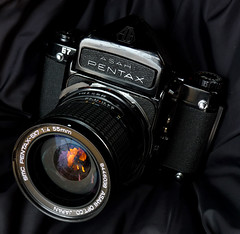
|
| Pentax 67 with prism (6x7) image by Paulo Moreira (Image rights) |
Pentax 67II
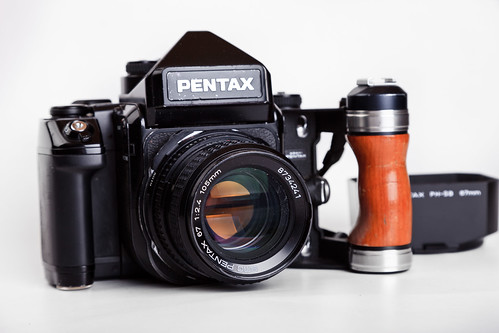
|
| 67II with AE prism finder and LH grip image by Ronald van Beek (Image rights) |
The Pentax 67II is the newest revision, released in 1998. Its specifications are very similar to those of the previous models. The most notable improvement is the built-in right-hand grip, making handling much easier. For those used to the handling of the previous models a left-hand grip can still be added to the body. A dedicated time mode switch (PS TIME) has been added below the mirror up dial. Using time mode on long exposures does not consume as much battery power as bulb mode. The PC terminal for FP (bulb) flash sync is no longer present; it has been replaced with the Pentax speedlight 5P connector. On this model an LCD panel located by the film advance lever shows information such as frame counter, film ISO, film load status, battery status, shutter cocking, and flash status. The film back still contains the film format (120/220) window but now has as an emulsion memo holder. The film start mark is now the same for both 120 and 220 film. The 220 format mode can now capture 21 exposures compared to the previous 20 exposures. A new self-timer mode is available, located on the same collar as the on/off dial. It has a 12-second delay with an audible beep. Multiple exposure mode is also available. The battery is now 2x CR123A lithium.
A new AE finder available for this model offers aperture priority exposure mode along with the basic manual, T, and B modes. In AE mode the shutter speed range is from 30s to 1/1000. Pentax also offered a half-stop modification to the shutter, so half speeds like 1/45 and 1/90 can also be used. An exposure compensation dial provides a range of 3 EV. An exposure lock feature allows the exposure settings to be retained in memory for 20 seconds. Along with center-weighted averaging metering modes, a spot mode and a multisegment metering mode are also offered. Film sensitivity measuring range is also expanded with a range from 6 to 6400 ISO. The viewfinder display uses LEDs for the display instead of a needle. Also displayed in the finder are shutter speed, aperture, flash status, metering mode, and exposure compensation. In manual exposure mode, under/over indication is shown. Note that the AE finder works only with the 67II, and the TTL finder from the 67 model is incompatible with the 67II.
System
Some most impressive optics make up the lenses available for this camera, including a range of leaf-shuttered ones that satisfy flash sync requirements and solve mirror and shutter vibration problems. The basic equipment would include the Super-Multi-Coated Takumar 6×7 1:2.4 f=105mm lens; the removable, true coverage pentaprism finder; and possibly the very useful, separately available left-hand grip with accessory shoe.
|
Lenses
Super-Multi-Coated - introduced 1971
|
SMC Pentax 6x7 - introduced 1980s
SMC Pentax 67 - introduced late 1990s
|
|
Finder
prism
focus screen
|
Body
Lens
Macro
|
Specs
| Pentax 6×7 | Pentax 6×7MLU | Pentax 67 | Pentax 67II | |
|---|---|---|---|---|
| Introduction | 1969 | 1976 | 1989 | 1998 |
| Type | 2 1/4 × 2 3/4 (6 × 7) Single lens reflex camera | |||
| Shutter speed | 1 to 1/1000 sec | 4 to 1/1000 sec | ||
| Flash sync | X: 1 to 1/30 of a sec | |||
| FP: 1/125 to 1/1000 of a sec | 5P: TTL 1/30 | |||
| Mirror lock up | No | Yes | ||
| Multiple exposure | No | Yes | ||
| Self timer | No | Yes | ||
| Strap lug | 4 | 2 | ||
| Grip | Optional left | Optional left and or right built-in | ||
| Battery | 4LR44 / PX28 | 2x CR123A | ||
| Battery ext | Yes | No | ||
| Dimensions | 184x101x91mm | 177x101x91mm | 185x108x92mm | |
| Weight | 1.29kg | 1.21kg | ||
Bibliography
- Kamera no ayumi. Zen nihon shashin renmei sōritsu 50-shūnen kinen (カメラのあゆみ・全日本写真連盟創立五〇周年記念, History of cameras, commemorating the 50th anniversary of the All Japan Association of Photographic Societies). Tokyo: Asahi Shinbunsha, 1976. No ISBN number. P.107.
- Lewis, Gordon, ed. The History of the Japanese Camera. Rochester, N.Y.: George Eastman House, International Museum of Photography & Film, 1991. ISBN 0-935398-17-1 (paper), 0-935398-16-3 (hard). Pp.122, 133, 176 and 182.
- McKeown, James M. and Joan C. McKeown's Price Guide to Antique and Classic Cameras, 12th Edition, 2005-2006. USA, Centennial Photo Service, 2004. ISBN 0-931838-40-1 (hardcover). ISBN 0-931838-41-X (softcover). P.84.
- Sugiyama, Kōichi (杉山浩一); Naoi, Hiroaki (直井浩明); Bullock, John R. The Collector's Guide to Japanese Cameras. 国産カメラ図鑑 (Kokusan kamera zukan). Tokyo: Asahi Sonorama, 1985. ISBN 4-257-03187-5. Items 3062–3.
Notes
- ↑ Shashin Kōgyō (Photographic Industries) No. 11 (1969) pp 38-47.
- ↑ By mid-1968 prototypes being shown to the press were still two-tone but the name "6x7," the specs, and the lens options at launch finalized. Interestingly, Fuji's overgrown rangefinder "Texas Leica," the Fujica G690 was also debuting at the same Photokina.
Links
In English:
- Pentax 6×7/67/67ii information at Photoethnography.com
- Pentax 6×7 and TTL Prism manuals at Mike Butkus' library of camera manuals
- Pentax 67 Manual and Pentax 67 II Manual from Pentax Imaging US
- Pentax 67 (6×7, 67, 67II) group on Flickr
- New Pentax 67II by Robert E. Mayer at Shutterbug
In Japanese:
In German
- Pentax67 in Olypedia (in German)
- Pentax 67 PDF manual (in German) at Butkus' OrphanCameras.com
